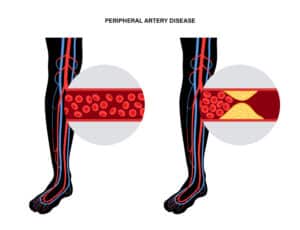In honor of February’s American Heart Month and the Amputee Coalition’s commitment to promoting limb loss prevention, we would like to highlight the dangers of peripheral artery disease (PAD). Note that PAD may also be referred to as peripheral arterial disease or peripheral vascular disease [1]. Affecting 8 million to 12 million Americans and climbing, this disease often goes undiagnosed but poses a risk factor for amputation if left untreated [2].
There are controllable factors such as the choice to stop smoking that can reduce your risk, but it’s important to be aware of how uncontrollable variables such as ethnic identity and aging contribute. Learn more about who is most at risk and what you can do today to safeguard your cardiovascular health.

What is PAD?
According to the American Heart Association, PAD is a narrowing of the peripheral arteries that carry blood away from the heart to other parts of the body. The most common type is lower-extremity PAD, in which blood flow is reduced to the legs and feet [3]. Poor circulation may result in limb amputation.
What causes PAD?
Atherosclerosis is the main culprit. This is the buildup of fatty plaque in the arteries that narrows and blocks them throughout the body, including the heart, brain, arms, legs, pelvis, and kidneys. When the artery walls narrow, blood flow is reduced.
Because many people with PAD never experience symptoms, prioritizing routine medical appointments is key to making an early diagnosis.
What are the most common symptoms of lower-extremity PAD?
Cramping, fatigue, aching, pain, or discomfort in the leg or hip muscles while walking or climbing (claudication). Tingling or weakness in your legs is also an indicator to visit your doctor immediately.
If left untreated, PAD can lead to gangrene (a serious condition in which tissue becomes discolored, infected, or dies), amputation, and other complications including coronary artery disease, heart attack, and stroke.
Am I at greater risk?
African Americans and anyone who has Type 2 diabetes or smokes is at the greatest risk of developing PAD. African Americans with PAD are at an increased risk to lose a limb, while people who have Type 2 diabetes and PAD are up to four times more likely to lose a limb [4]. Other risk factors include aging, high blood pressure or cholesterol, being overweight or physically inactive, family history, and being a military veteran.
What can I do to decrease my risk?
- Manage risk factors under your control (manage diabetes and blood sugar levels, stop smoking)
- Maintain a healthy weight and lifestyle by eating healthy and exercising regularly
- Make regular appointments with healthcare professionals
- Take off your socks and let your doctor examine your feet
By making healthy lifestyle choices and receiving treatment, it is possible to stop PAD from getting worse and in some cases reverse symptoms. Take a proactive approach to your health. Your body will thank you!
[1] Peripheral Vascular Disease | Johns Hopkins Medicine
[2] Peripheral Artery Disease | Cleveland Clinic
[3] What is Peripheral Artery Disease? | American Heart Association
[4] Are You at Risk for PAD? | American Heart Association

